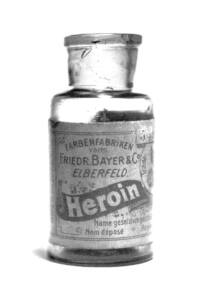History of Heroin

The deaths of popular actors Philip Seymour Hoffman and Glee’s Cory Monteith have thrust the dangers of heroin usage into the spotlight; however, it’s an epidemic that began long before Hollywood even existed.
It is believed that the opium poppy was cultivated in lower Mesopotamia by the Sumerians around 3400 B.C. and was referred to it as the “joy plant.” Opium has been cultivated and used throughout the world for hundreds of years and made its way to the United States in the 1800s through Chinese immigrates who came to the U.S. to help build the railroads. Opium was more popular than alcohol, and many people would buy it at saloons or at “opium dens”. Opium was not only used recreationally, it was also used medically as a pain reliever. Doctors frequently prescribed medicines containing opium to middle and upper class women who were suffering from “female problems.”
During the early 1800s, German pharmacist Friedrich Sertuerner found a way to isolate and abstract morphine, a psychoactive chemical, from opium. By the mid 1800s morphine was available in the U.S. and with the invention of the hypodermic syringe it was a convenient way to relieve pain. During the Civil War morphine usage increased as it became the go-to pain reliever for war-related injuries. Because morphine is heavily addictive, causing physical and mental dependency, thousands of Civil War soldiers soon became morphine addicts.
In 1874 English researcher, C.R. Wright first developed diacetylmorphine (later known as heroin) by boiling morphine on his stove; however, credit for the discovery is often given to Heinrich Dreser. Dreser worked for The Bayer Company of Germany and created heroin in 1895. In 1898 the Bayer Company of Germany announced they had found a substitute for morphine and marketed heroin as a pain reliever without the addictive side effects of morphine. Heroin was sold over-the-counter as a common medication to relive coughs, chest pains, and pains associated with tuberculosis; it was often sold in a kit that came with a syringe. Heroin was also used to treat and eliminate morphine addiction; however, while it steered people away from morphine, an epidemic of heroin addiction was born.
The Harrison Narcotics Tax Act was passed in the U.S. in 1914 as a way to control the sale of heroin and other opiates by requiring doctors and pharmacists who prescribed these drugs to register and pay a tax. The U.S. Treasury Department’s Narcotics Division then banned legal narcotics sales in 1923. A year later, in 1924, the Heroin Act made the manufacturing and possession of heroin illegal, which forced addicts to illegally purchase heroin from street dealers. In the 1930s, the Federal Bureau of Narcotics was developed; however, heroin was still smuggled from Asia into the U.S., with a huge black market in New York City.
Heroin trafficking to the U.S substantially decreased during World War II because the war had disrupted the normal international distribution routes used to transport heroin and opium.
After World War II, the Mafia took advantage of the powerless Italian government and set up heroin labs in Sicily. The Mafia took advantage of Sicily’s location and was able to distribute heroin into Europe and the United States. At this same time, heroin production in China ended when the communists won and took power.
During the 1950s the U.S. aimed to prevent the spread of communism in Asia, which meant the U.S. needed to form alliances with the warlords and tribes of Laos, Thailand, and Burma. This region was known as the Golden Triangle and was (and still is) one of the world’s top two producers of opium. As a result of this alliance, there was a huge increase in the illegal production and sale of heroin in the U.S.
Because heroin was easily accessible and cheap in Vietnam, many U.S. soldiers experimented with it while serving in the Vietnam War. When Vietnam’s capital, Saigon, was captured, the “China White” heroin of Asia was no longer available to the dealers and addicts of the U.S. causing dealers to find a new source of opium. In the 1970s dealers sold heroin known as “Mexican Mud” which was derived from opium smuggled from Mexico. In the late 1970s, another source of heroin was found in the Middle East, predominately in Iran, Afghanistan and Pakistan. During this time, heroin usage was increasingly high in inner cities throughout the U.S.; it was also reported by NPR that close to 20% of Vietnam vets were also addicts.
Heroin prices increased in 1980s and heroin usage began to decline and continued its decline throughout the 90s as people experimented with crack and powdered cocaine. Ecstasy, which was a drug of the 70s, also made its way back into the drug scene and was a drug of choice for club-goers. The spread of HIV/AIDS also contributed to the decline in heroin use as people steered away from using needles.
While heroin may have taken a backseat to other drugs during the past couple of decades, it has returned with a vengeance. An epidemic of heroin use has spread throughout the country, with many of its users being middle to upper class people who are searching for ways to replace their addictions to prescription painkillers.
For more information, please visit:
Heroin Addiction’s Fraught History
Back to Drugs
Back to Crime Library
|
|
|

